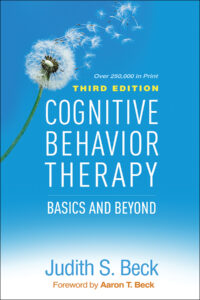By Judith S. Beck, PhD
Beck Institute President
I’m excited to introduce the third edition of Cognitive Behavior Therapy: Basics and Beyond, published on September 30 with a great deal of new material. Before writing this revision, I asked for feedback on the second edition from mental health practitioners all over the world. The excellent responses I received helped me conceptualize the changes and additions I needed to make. This edition incorporates the feedback I received and reflects the most recent research and current directions for the field of Cognitive Behavior Therapy.
One piece of feedback that I consistently received was that readers wanted to see a more complex client as the major example throughout the book. “Abe,” the client illustration in this edition, is severely depressed and struggles with unemployment and a recent divorce. I have also included a second client example, “Maria,” who has borderline personality traits. The third edition includes links to a library of accompanying videos and transcripts of full therapy sessions with Abe, worksheets, and other resources to help readers extend their learning.
Another important change is that I’ve revised much of the material to include both our traditional CBT orientation and a recovery orientation. Recovery-Oriented Cognitive Therapy (CT-R) is a cutting-edge, evidence-based treatment for individuals diagnosed with serious mental illness, including schizophrenia, many of whom have been hospitalized for decades. CT-R was developed, and is being researched, by my father, Dr. Aaron Beck, and his research/training group who are now part of the Beck Institute Center for Recovery-Oriented Cognitive Therapy. Our other clinician/educators and I have been adapting this approach for use with our non-hospitalized clients who experience a wide range of psychiatric disorders, psychological problems, and medical conditions with psychological components.
The recovery orientation focuses on identifying clients’ values and aspirations (and the meaning of their aspirations) and helping them create a sense of purpose and empowerment in their lives by taking steps each week in pursuit of their goals. We also focus on helping clients reach positive conclusions about themselves, others, and their future as a result of taking these steps, and we identify and reinforce their positive qualities, skills, and resources. We emphasize experiencing positive emotion both in and out of sessions. We expect that the recovery movement will play a large role in shaping the future of CBT, and psychotherapy in general, in the coming years and decades.
I’ve also included a new chapter on the therapeutic relationship, a new chapter on integrating mindfulness into CBT, and techniques from other evidence-based modalities such as Acceptance and Commitment Therapy (ACT), Dialectical Behavior Therapy (DBT), and Mindfulness-Based Cognitive Therapy (MCBT). Readers will learn how to establish and maintain a sound therapeutic relationship and conceptualize and repair ruptures. Mindfulness is a practice that has gained traction among therapists over the past few years and can be an important therapeutic intervention when integrated into CBT within the context of a sound cognitive conceptualization.
Finally, I have written this edition in a more reader-friendly style. When I teach our in-house workshops or online courses, I often include clinical examples of my own clients. I also encourage participants to take part in interactive activities, role playing with another participant, and presenting their own challenging cases for feedback and discussion. Most participants find these hands-on experiences to be an important part of transferring knowledge to practice. In this edition of the book, I not only use a more personal approach in my writing, but I have also included clinical tips from my own practice, reflection questions, and suggested activities to help readers engage with the material.
I always say that learning CBT is a lifelong endeavor. No matter where you are on your journey, I hope the new edition of the book inspires you to learn more about CBT.
